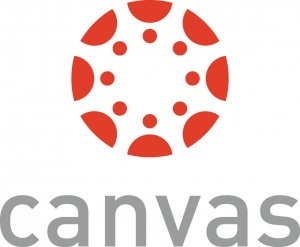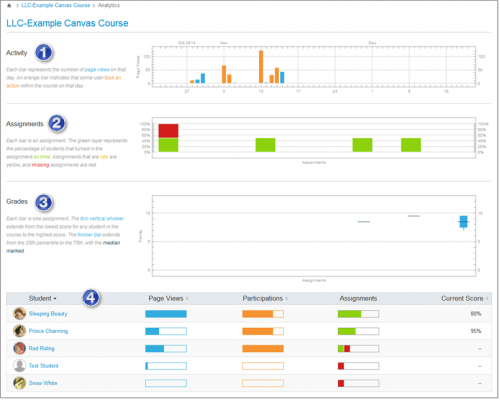Canvas
Canvas LMS is a web-based learning management system developed by Instructure, Inc. which provides an interface for educators and students to interact, complete coursework and receive feedback on submissions among other features. Canvas is marketed for use in K-12 schools, higher education and large businesses[1].
Overview

Canvas is defined as “an open and reliable web-based software that allows institutions to manage digital learning, educators to create and present online learning materials and assess student learning, and students to engage in courses and receive feedback about skill development and learning achievement”[3]. Canvas provides an array of features for both students and instructors. Such features include files, calendar, syllabus, assignments, grades, discussion boards, private chat, Zoom links, and even a list of classmates. Besides a textbook, everything a student is expected to need for an online course is conveniently stored into one location, providing an organized interface for all parties involved in the course. In addition, Canvas has three iOS apps: Canvas Student, Canvas Teacher, and Canvas Parent. These allow the user to stay aware of course content while on the go. While Canvas competes with other learning management systems such as Blackboard and Google Classroom, the demand for these systems is expected to increase[4]. In August of 2020, thirteen states adopted Canvas for their statewide educational system[5], making it the number one Learning Management System in North America[6].
Analytics

While externally this platform is beneficial to all parties involved, internally, educators reap even more benefits. In the pre-covid era when in-person instruction was the only option, teachers were able to get a general view of students who pay attention and actively participate, versus those who do not show effort in class. Now, with the development of Canvas Analytics, teachers can enhance their assessment by monitoring student activity via the course page. This tool provides an opportunity for teachers to correlate a student’s behavior on the canvas page with their performance in the class. With this unprecedented amount of data, teachers are able to infer potential causation for why one student is falling behind compared to another, by assessing their time spent engaging with the course material and utilizing the resources provided by the teacher[8].
When an instructor first logs into Canvas, they are able to click on Course Analytics to view a graph or table representation of each student’s data. These analytics are divided into four categories: activity, submissions, grades, and student analytics. Activity measures participation and engagement, highlighting the number of page views and levels of interactions with course content from each student. The submissions tab refers to the quizzes and assignments that are distributed. This category measures the timely, or untimely, manner in which a student submits their assignments. Meanwhile, the grades section offers a box and whisker plot of the class grade distribution.This plot describes the median, lowest, and highest scores produced by the class, allowing the teacher a more comprehensive glimpse of a student’s success relative to their peers. The final measurement gives a breakdown of these categories by student, providing an overall view of this students’ progress, or lack thereof, in a course[9].
Ethical Ramifications
Covid
Due to the global pandemic, universities have been forced to implement a virtual learning system to maintain a substantive academic experience, however, this transition has exacerbated already prominent concerns about surveillance and privacy. Although students are familiar with the structure of Canvas, the significance of this platform as an asset to the universities it serves, has increased due to the vast array of functions and features available [10].
The primary purpose of teachers having this unparalleled access to data is to better understand the level of commitment and overall engagement presented by each student to the course. After partaking in online courses for over a year, it is clear that the level of transparency and communication between students and teachers is minimized due to the nature of completing coursework online[11]. For example, when students come to professors seeking advice or counsel on how to improve their grade, the professor can refer to the data provided by Canvas to convey to the student, how and why their level of interaction with the course, correlates with their grade.
With this being said, the plausibility for error in student assessment is significant because, on a personal level, each student is entitled to their preferred learning strategy. This level of oversight by the teachers has raised concern for students because of their lack of privacy as well as how objective the assessment is[12]. More often than not, each student will engage with a certain amount of course material that they see fit. Some require more effort than others to achieve success and the uncertainty in whether a teacher will only use these analytics as a direct correlation to their success or not is interesting. It suggests that regardless of the overall outcome, a teacher could primarily assess a student’s work due to the data presented by Course Analytics, increasing their risk of having an incomplete understanding of the student’s achievement[13].
Notes
- ↑ https://www.instructure.com/canvas
- ↑ Empson, R. (2012, November 01). With 4.5M Users, Instructure Takes On The Courseras & Udacities Of The World With Its Own Open Course Network. Retrieved March 12, 2021, from https://techcrunch.com/2012/10/31/instructure-canvas-network/
- ↑ What is Canvas? (2021, March 05). Retrieved March 12, 2021, from https://community.canvaslms.com/t5/Canvas-Basics-Guide/What-is-Canvas/ta-p/45
- ↑ LMS Market. (n.d.). Retrieved March 12, 2021, from https://www.marketsandmarkets.com/Market-Reports/learning-management-systems-market-1266.html
- ↑ Instructure, C. (2020, August 20). 13 States partner with Canvas LMS to Support educators, students, and parents. Retrieved March 12, 2021, from https://www.prnewswire.com/news-releases/13-states-partner-with-canvas-lms-to-support-educators-students-and-parents-301115753.html
- ↑ Canvas Overview. (n.d.). Retrieved March 12, 2021, from https://www.instructure.com/canvas
- ↑ Viewing Course Data. (n.d.). Retrieved March 12, 2021, from https://lakeland.instructure.com/courses/740304/pages/viewing-course-data
- ↑ Johnson, T. (2020, April 03). Using Canvas Analytics to Ensure Student Engagement. Retrieved March 12, 2021, from https://otl.du.edu/using-canvas-analytics-to-ensure-student-engagement/
- ↑ What do Instructors see for Analytics or Statistics in Canvas? (2016, September). Retrieved March 12, 2021, from https://canvas.colostate.edu/wp-content/uploads/sites/41/2018/05/CanvasAnalyticsIntro_WebVersion.pdf
- ↑ Strauss, V. (2020, March 23). As schooling rapidly moves online across the country, concerns rise about student data privacy. Retrieved March 12, 2021, from https://www.washingtonpost.com/education/2020/03/20/schooling-rapidly-moves-online-across-country-concerns-rise-about-student-data-privacy/
- ↑ Lederman, D. (2019, October 30). Professors' slow, steady acceptance of online learning: A Survey. Retrieved March 12, 2021, from https://www.insidehighered.com/news/survey/professors-slow-steady-acceptance-online-learning-survey
- ↑ Biederman, A. (2017, October 10). Professors can monitor student activity through Canvas. Retrieved March 12, 2021, from https://temple-news.com/professors-can-monitor-student-activity-canvas/
- ↑ Martin, Florence and Ndoye, Abdou, Using Learning Analytics to Assess Student Learning in Online Courses, Journal of University Teaching & Learning Practice, 13(3), 2016. Available at:http://ro.uow.edu.au/jutlp/vol13/iss3/7